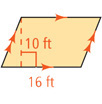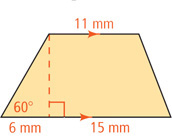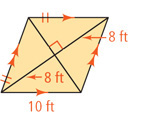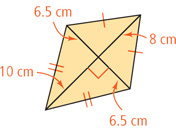10-1 Areas of Parallelograms and Triangles
Quick Review
You can find the area of a rectangle, a parallelogram, or a triangle if you know the base b and the height h.

The area of a rectangle or parallelogram is
The area of a triangle is
Example
What is area of the parallelogram?

The area of the parallelogram is
Exercises
Find the area of each figure.
-

-

-

-

- A right triangle has legs measuring 5 ft and 12 ft, and hypotenuse measuring 13 ft. What is its area?
10-2 Areas of Trapezoids, Rhombuses, and Kites
Quick Review
The height of a trapezoid
h is the perpendicular distance between the bases,

The area of a trapezoid is
The area of a rhombus or a kite is

Example
What is the area of the trapezoid?

The area of the trapezoid is
Exercises
Find the area of each figure. If necessary, leave your answer in simplest radical form.
-

-

-

-

- A trapezoid has a height of 6 m. The length of one base is three times the length of the other base. The sum of the base lengths is 18 m. What is the area of the trapezoid?
Table of Contents
- 6-1 The Polygon Angle-Sum Theorems
- 6-2 Properties of Parallelograms
- 6-3 Proving That a Quadrilateral Is a Parallelogram
- 6-4 Properties of Rhombuses, Rectangles, and Squares
- 6-5 Conditions for Rhombuses, Rectangles, and Squares
- 6-6 Trapezoids and Kites
- 6-7 Polygons in the Coordinate Plane
- 6-8 and 6-9 Coordinate Geometry and Coordinate Proofs




